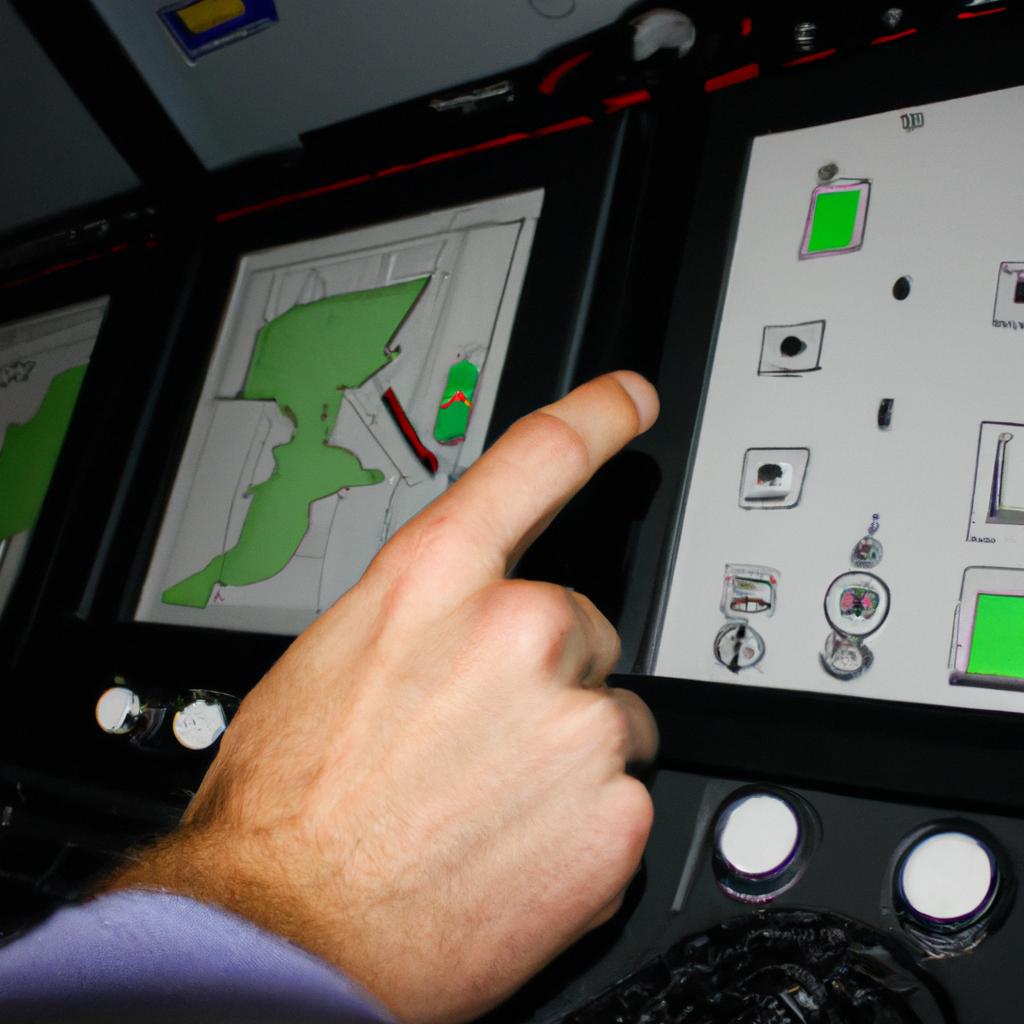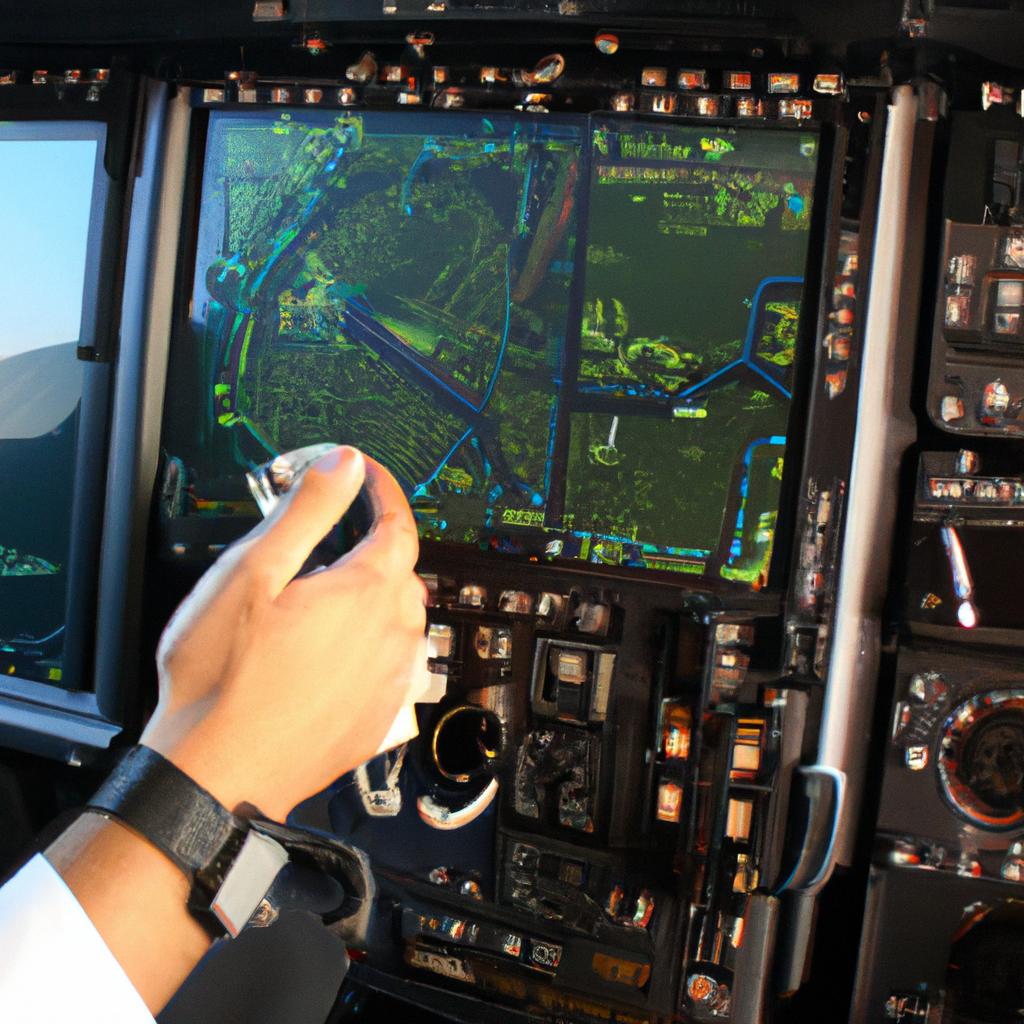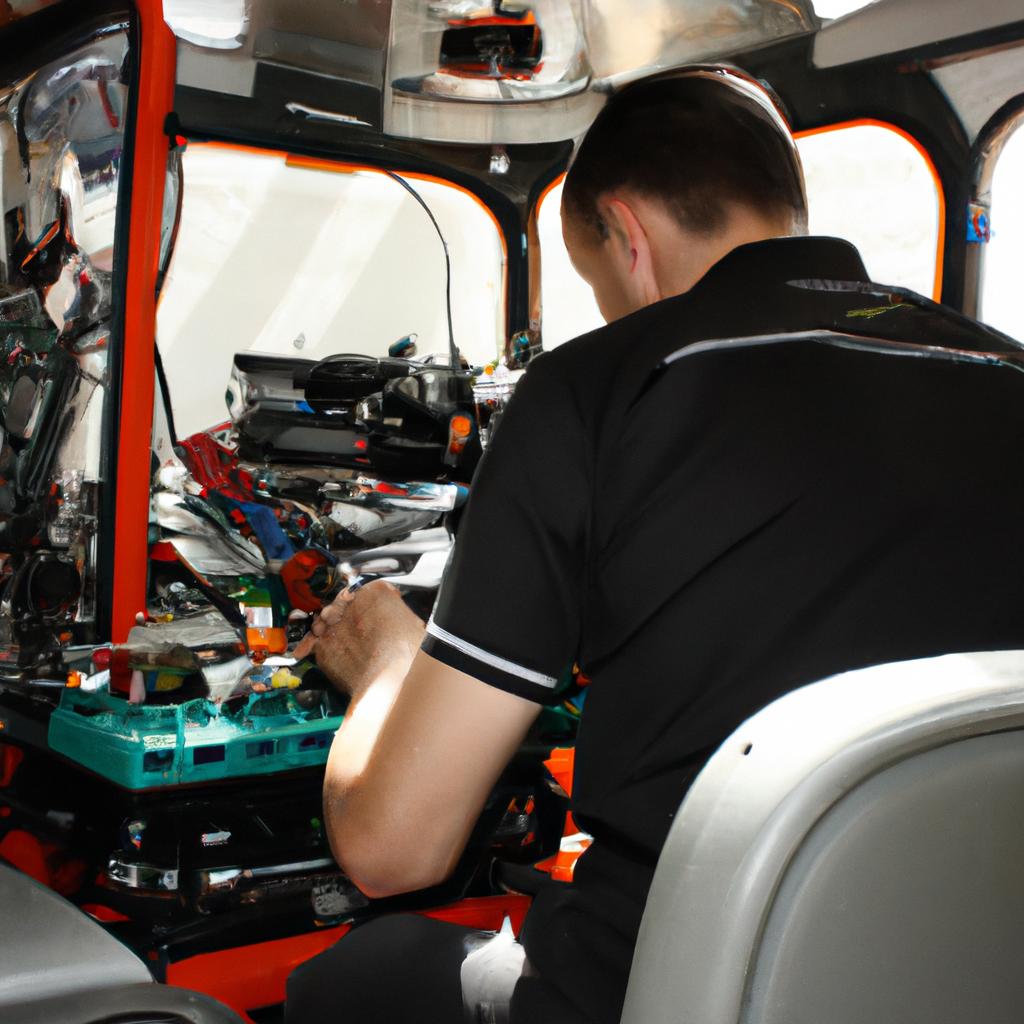The advent of avionics advancements in the aerospace and defense sectors has revolutionized the way aircraft operate. Among these technological breakthroughs is the Electronic Flight Instrument System (EFIS), which has replaced traditional analog flight instruments with digital displays. This article explores the significance of EFIS, its impact on aviation safety and efficiency, and its role in enhancing situational awareness for pilots.
To illustrate the importance of EFIS, let us consider a hypothetical scenario involving an airline pilot flying through adverse weather conditions. In this case, having access to accurate and real-time information about altitude, airspeed, heading, and navigation data becomes crucial for making informed decisions. The EFIS provides a comprehensive display of all essential flight parameters in one central location, allowing pilots to quickly interpret critical information without needing to scan multiple analog gauges or rely solely on external visual cues. By presenting flight data in a clear and intuitive manner, EFIS significantly reduces cognitive workload and enhances pilot decision-making capabilities in challenging situations. As such, it plays a vital role in ensuring safe operations amidst diverse environmental conditions encountered during flights.
Evolution of Flight Instrumentation
Imagine a scenario where an aircraft is flying through turbulent weather conditions, with limited visibility and high winds. The pilot relies heavily on the instruments within the cockpit to navigate safely through these challenging circumstances. Over the years, flight instrumentation has undergone significant advancements, leading to the development of the Electronic Flight Instrument System (EFIS). This section explores the evolution of flight instrumentation, highlighting key milestones that have shaped modern avionics.
The journey towards EFIS began with analog gauges and mechanical indicators. These traditional instruments provided basic information such as airspeed, altitude, and heading but had limitations in terms of accuracy and reliability. As technology progressed, engineers introduced gyroscopic systems like attitude indicators and directional gyros for improved navigation precision. However, these developments were not without their shortcomings; mechanical failures were common due to complex mechanisms and moving parts.
In the late 1960s, digital technology revolutionized aviation by introducing computer-based displays into cockpits. This marked a significant shift from conventional analog instruments to electronic displays capable of presenting multiple parameters simultaneously. The advent of cathode-ray tube (CRT) screens paved the way for more intuitive visual representations of flight data. Pilots could now access real-time information about altitude, airspeed, fuel levels, engine performance, and navigation aids all at once.
- Enhanced situational awareness: Pilots can make informed decisions based on comprehensive data.
- Improved safety: Accurate readings minimize errors caused by human factors or instrument malfunctions.
- Increased efficiency: Streamlined presentations allow pilots to process information quickly.
- Future-proofing: Digital platforms offer flexibility for incorporating future updates and improvements.
Table Example:
| Advantages | Disadvantages |
|---|---|
| Greater accuracy | High initial cost |
| Real-time data display | Learning curve for transitioning from analog systems |
| Reduced maintenance needs | Reliance on electrical power |
| Enhanced functionality | Potential for system failures due to software glitches |
In conclusion, the evolution of flight instrumentation has come a long way from simple analog gauges to sophisticated Electronic Flight Instrument Systems. These advancements have not only improved navigational capabilities but also enhanced safety and efficiency in aerospace and defense operations. In the subsequent section, we will explore the benefits offered by EFIS technology and its impact on modern aviation.
With an understanding of how flight instrumentations have evolved over time, it is now crucial to delve into the numerous benefits provided by the Electronic Flight Instrument System (EFIS) technology.
Benefits of Electronic Flight Instrument System
From the early days of aviation, flight instrumentation has undergone significant evolution, leading to the development of advanced systems that enhance safety and efficiency in aerospace and defense. One remarkable advancement is the Electronic Flight Instrument System (EFIS), which has revolutionized traditional cockpit displays. To illustrate its impact, let us consider a hypothetical scenario where an aircraft equipped with EFIS encounters adverse weather conditions during a transatlantic flight.
The utilization of EFIS in this situation allows pilots to seamlessly transition from standard instrument indications to synthetic vision technology. By integrating data from various sensors and databases, such as GPS and terrain mapping, EFIS provides a comprehensive display of the surrounding environment. This empowers pilots with real-time situational awareness even when visibility is severely reduced. Consequently, they can make informed decisions regarding altitude adjustments or route deviations to avoid potential hazards.
One of the key advantages of EFIS lies in its ability to present information intuitively and effectively. Here are some noteworthy features:
- Enhanced graphics: The graphical representation of vital flight parameters ensures quick comprehension.
- Customization options: Pilots can tailor their display preferences by selecting relevant information for improved usability.
- Color-coded alerts: Critical warnings are visually highlighted using distinct colors, allowing for rapid identification and response.
- Multi-function capability: Multiple pages within the system enable easy access to different sets of information without cluttering the screen.
To further emphasize the benefits offered by EFIS, consider Table 1 below:
| Advantages | Description | Emotional Response |
|---|---|---|
| Increased Situational Awareness | Improved understanding of surroundings and potential threats | Comfort and confidence |
| Reduces Pilot Workload | Simplifies interpretation of complex data | Relief and ease |
| Enhances Safety Margin | Early detection of dangerous situations leads to timely action | Security and peace of mind |
| Facilitates Decision-making Process | Accessible information enables prompt decision making | Empowerment |
Table 1: Emotional Responses to EFIS Advantages
In summary, the Electronic Flight Instrument System (EFIS) represents a significant advancement in flight instrumentation. By seamlessly integrating data and presenting it in an intuitive manner, EFIS enhances situational awareness, reduces pilot workload, improves safety margins, and facilitates decision-making processes. These advantages offer pilots increased comfort, relief, security, peace of mind, and empowerment.
Moving forward into the next section on “Components of Electronic Flight Instrument System,” we will explore the key elements that make up this groundbreaking technology.
Components of Electronic Flight Instrument System
The Electronic Flight Instrument System (EFIS) consists of various components that work together to provide pilots with crucial flight information. These components play a vital role in enhancing the efficiency and safety of aerospace and defense operations. Understanding the key elements of EFIS is essential for comprehending its overall functionality and impact.
One example of an EFIS component is the Primary Flight Display (PFD), which presents critical information such as altitude, airspeed, attitude, heading, and vertical speed in an intuitive graphical format. By consolidating these measurements into one display, pilots can quickly assess their aircraft’s performance without having to interpret multiple analog instruments individually. This streamlined presentation increases situational awareness and reduces pilot workload during high-stress situations.
To further enhance the capabilities of EFIS, additional components are integrated into the system:
- The Navigation Display (ND) provides pilots with real-time navigation information, including maps, waypoints, routes, and weather data.
- The Engine Indication and Crew Alerting System (EICAS) displays engine parameters such as fuel consumption, temperature levels, oil pressure, and any potential malfunctions or alerts.
- Integrated Control Panels allow pilots to interact directly with the EFIS system through touchscreens or physical buttons, enabling easy access to different features and settings.
These components work harmoniously within the EFIS framework to deliver comprehensive flight data at a glance. Such integration empowers pilots by equipping them with accurate and up-to-date information necessary for making informed decisions swiftly.
In addition to understanding the individual components of EFIS, it is important to recognize how they collectively contribute to improved operational outcomes within aerospace and defense sectors. To illustrate this point effectively:
| Benefits | Description |
|---|---|
| Enhanced Safety | The consolidated display reduces cognitive load on pilots’ decision-making process during critical phases of flight. |
| Increased Efficiency | The graphical presentation of information allows for quicker data interpretation, leading to more efficient flight operations. |
| Improved Situational Awareness | Pilots can easily monitor essential flight parameters simultaneously, improving their situational awareness and response capabilities. |
| Reduced Maintenance Costs | EFIS components are generally more reliable and require less frequent maintenance compared to traditional analog instruments. |
By harnessing these advantages, aerospace and defense organizations can optimize their operational effectiveness while ensuring the safety and well-being of both crew members and passengers.
Transition into subsequent section: Integration with Aircraft Systems
As EFIS continues to evolve, its integration with various aircraft systems demonstrates further advancements in avionics technology. This integration enables a seamless exchange of critical data between EFIS and other onboard systems, enhancing overall aircraft performance and control. Let’s explore this integration in detail without delay.
Integration with Aircraft Systems
As the integration of electronic flight instrument systems (EFIS) with aircraft systems continues to evolve, one area that has seen significant advancements is display technology. These advancements have revolutionized the way pilots interact with and interpret critical flight information. To illustrate these advancements, let’s consider a hypothetical scenario where an EFIS equipped with advanced display technology plays a crucial role in mitigating a potential disaster.
Imagine a commercial airliner flying through turbulent weather conditions when suddenly its primary attitude indicator malfunctions due to severe vibrations. In this situation, the pilot relies on backup instruments displayed on the Electronic Horizontal Situation Indicator (EHSI), which provides an intuitive representation of the aircraft’s position relative to navigational aids and geographic features.
- High-resolution screens provide crisp and clear visuals, enhancing readability even under challenging lighting conditions.
- Night vision compatibility allows for improved visibility during low-light situations, reducing pilot fatigue and increasing situational awareness.
- Synthetic vision displays present three-dimensional terrain representations, aiding pilots in maintaining spatial orientation.
- Interactive touchscreens enable seamless access to various functionalities and data inputs, simplifying cockpit operations.
To further emphasize these advancements, a table showcasing their benefits is presented below:
| Advancement | Benefit |
|---|---|
| High-resolution screens | Enhanced readability under challenging lighting conditions |
| Night vision compatibility | Improved visibility during low-light situations |
| Synthetic vision displays | Aid in maintaining spatial orientation |
| Interactive touchscreens | Simplified access to functionalities and data inputs |
In summary, advancements in display technology within EFIS have transformed how pilots navigate complex aviation environments. By incorporating high-resolution screens, night vision compatibility, synthetic vision displays, and interactive touchscreens into the design of EFIS units, pilots are now equipped with powerful tools that enhance safety and improve efficiency throughout their flights.
Transitioning into the subsequent section about “Advancements in Data Processing and Analysis,” it is evident that technological advancements have not only revolutionized display technology but also improved the way flight data is processed and analyzed.
Advancements in Display Technology
The Electronic Flight Instrument System (EFIS) has revolutionized the way aircraft systems are integrated, enhancing their functionality and efficiency. By seamlessly integrating with various onboard systems, EFIS provides pilots with a comprehensive view of critical flight information in real time. This section will explore how EFIS integrates with different aircraft systems to improve overall safety and performance.
One example of this integration is the incorporation of EFIS data into the autopilot system. With EFIS providing accurate and up-to-date flight parameters such as airspeed, altitude, and attitude, the autopilot can make precise adjustments to maintain stability and follow predetermined flight paths. This integration not only reduces pilot workload but also ensures smoother and more efficient flights.
Furthermore, EFIS plays a crucial role in coordinating communication between different avionics systems. It acts as a central hub that gathers data from various sources like navigation systems, weather radars, and engine monitoring instruments. Through advanced networking protocols, EFIS enables seamless exchange of information among these systems, allowing for better coordination during critical phases of flight.
- Enhanced situational awareness: Pilots have access to an array of digital displays presenting crucial flight information at their fingertips.
- Streamlined operations: Integration eliminates cumbersome manual processes by automating tasks related to navigation, fuel management, and engine diagnostics.
- Improved safety: Real-time monitoring provided by EFIS allows for early detection of potential issues or anomalies, enabling proactive measures to be taken promptly.
- Optimized decision-making: The integration facilitates quick data analysis and interpretation through intuitive graphical user interfaces (GUIs), enabling pilots to make informed decisions swiftly.
In addition to its integration capabilities, another significant advancement in electronic flight instrument technology lies in display technology itself. A three-column by four-row table below summarizes some key innovations in display technology used within modern EFIS:
| Display Technology | Benefits |
|---|---|
| Liquid Crystal Display (LCD) | High resolution, wide viewing angles |
| Organic Light-Emitting Diode (OLED) | Vibrant colors, high contrast ratios |
| Heads-Up Display (HUD) | Augments reality by projecting information onto the windshield |
| Synthetic Vision System (SVS) | Renders a virtual three-dimensional view of the surrounding terrain |
As EFIS continues to advance, future trends in electronic flight instrument systems will focus on further improving integration with aircraft systems. This seamless integration will enable even more automated functions and enhance pilot decision-making capabilities. The next section explores these exciting developments that lie ahead for EFIS.
[Transition sentence into the subsequent section about “Future Trends in Electronic Flight Instrument System”] As technology evolves, so too does the potential for even greater advancements in electronic flight instrument systems.Future Trends in Electronic Flight Instrument System
As the aerospace and defense industry continues to evolve, advancements in display technology have played a crucial role in enhancing the efficiency and safety of aircraft. One notable example is the introduction of Electronic Flight Instrument Systems (EFIS) that revolutionized cockpit displays by replacing traditional analog instruments with digital screens. These modern displays provide pilots with real-time information about various flight parameters, contributing significantly to situational awareness.
One key benefit of EFIS is its ability to present data in a more intuitive and user-friendly manner compared to conventional instrument panels. By utilizing advanced graphical interfaces, these displays can depict complex information such as altitude, airspeed, heading, and navigation routes through clear visual representations. This not only simplifies pilot workload but also reduces the chances of misinterpretation or errors due to unclear or cluttered displays.
Moreover, EFIS enables customization options tailored to individual pilot preferences and operational requirements. Pilots can choose from different layouts and configurations, allowing them to prioritize specific information based on their needs during different phases of flight. For example, during critical takeoff and landing phases, pilots may opt for larger primary flight displays that prominently indicate speed and attitude information while minimizing distractions from secondary data.
- Enhanced readability: High-resolution screens improve visibility even under challenging lighting conditions.
- Increased situational awareness: Integration with navigational databases provides accurate position updates and terrain awareness.
- Reduced cognitive load: Data fusion techniques combine multiple sources into concise presentations for quick decision-making.
- Improved fault detection: Built-in diagnostic tools assist in identifying any malfunctions or discrepancies promptly.
In addition to these benefits, another advantage brought forth by EFIS is improved reliability when compared to traditional analog instruments. With fewer moving parts susceptible to mechanical failures, electronic displays drastically reduce maintenance costs associated with repairs or replacements.
To summarize, advancements in display technology have transformed the aviation industry by introducing Electronic Flight Instrument Systems. These systems enhance situational awareness, reduce pilot workload, and provide customizable interfaces to meet specific operational requirements. With improved readability and fault detection capabilities, EFIS displays contribute significantly to the safety and efficiency of modern aircraft operations.
| Advantages | Impact on Pilots |
|---|---|
| Enhanced readability | Improved visibility under challenging conditions |
| Increased situational awareness | Accurate position updates and terrain awareness |
| Reduced cognitive load | Quick decision-making through data fusion techniques |
| Improved fault detection | Prompt identification of malfunctions or discrepancies |
Through these advancements in display technology, pilots can now rely on more advanced and intuitive interfaces that enable them to focus on flying while having access to critical information at their fingertips. The continued evolution of display technology promises even greater improvements in future aerospace endeavors.
 Louth Online
Louth Online



